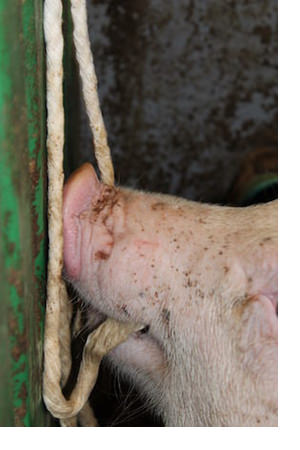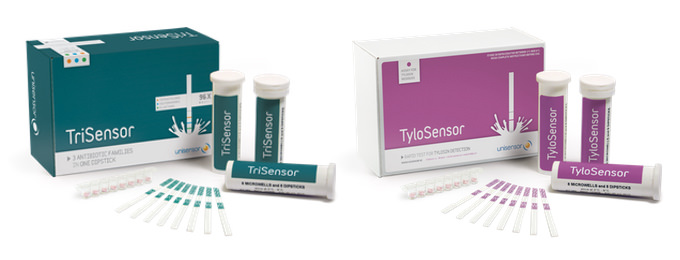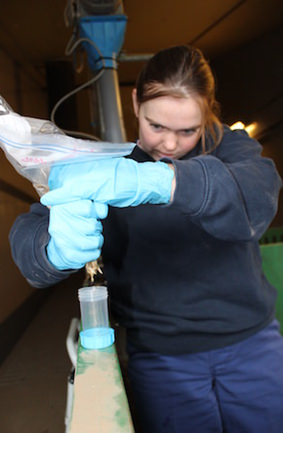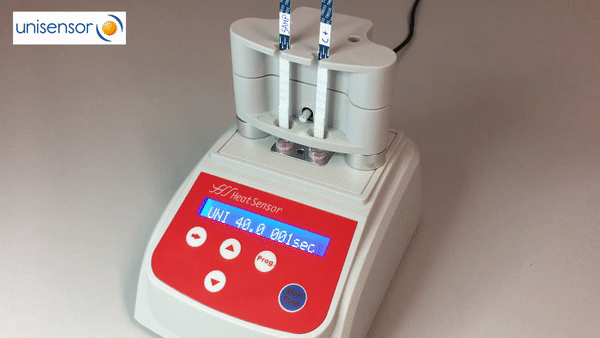- Unisensor | Blog
- First Ever Antibiotic Test Of Pig Meat Using Saliva
First Ever Antibiotic Test Of Pig Meat Using Saliva
Thanks to Unisensor products (TriSensor and TyloSensor), the ILVO Institute developed a method to detect the presence of antibiotic residues in the saliva of live pigs. Read more about this world premiere…
Antibiotics are used in animal husbandry to cure animals, prevent infections or, in some countries, promote their growth. Overuse and misuse of antibiotics on farms contributes to the spread of antibiotic resistance. The presence of antibiotic resistant bacteria at farm level poses a risk to society as a whole. Antibiotics become less or no longer effective and bacterial infections become more difficult or impossible to eradicate.
Farmers and the meat industry have an obligation to ensure that antibiotic residues which may be present in the meat of treated animals are not present above maximum residue limits (MRL).
A World Premiere
 At the request of FEBEV (the Federation of Belgian Meat and representative of slaughterhouses and cutting plants), the ILVO (Research Institute For Agriculture, Fisheries And Food Research) developed a method to detect the presence of antibiotic residues in the saliva of live pigs. This saliva is conveniently collected by hanging a string (of natural fiber) in the loft of pigs mature for slaughter and then squeezed out to be analysed. Saliva is found to be a very good and sensitive indicator for detecting antibiotic residues before slaughtering. Managing Director of FEBEV Michael Gore: "Belgium is already the first country in the world where a preventive antibiotics ante-mortem test is used in the pig sector, in addition to the antibiotics controls by the FASFC (Federal Agency for the Safety of the Food Chain) at the slaughterhouse.
At the request of FEBEV (the Federation of Belgian Meat and representative of slaughterhouses and cutting plants), the ILVO (Research Institute For Agriculture, Fisheries And Food Research) developed a method to detect the presence of antibiotic residues in the saliva of live pigs. This saliva is conveniently collected by hanging a string (of natural fiber) in the loft of pigs mature for slaughter and then squeezed out to be analysed. Saliva is found to be a very good and sensitive indicator for detecting antibiotic residues before slaughtering. Managing Director of FEBEV Michael Gore: "Belgium is already the first country in the world where a preventive antibiotics ante-mortem test is used in the pig sector, in addition to the antibiotics controls by the FASFC (Federal Agency for the Safety of the Food Chain) at the slaughterhouse.
The analysis of the saliva is based on two existing dipstick tests from Unisensor (TriSensor and TyloSensor) used for testing the presence of antibiotic residues in milk.


Barely 10 minutes after collecting the saliva, you get the result. The farmer, driver, or an employee of the slaughterhouse may hang up the rope as a toy. Within a couple of minutes, the pigs have sucked the rope. Then the rope goes into a plastic bag. You wring everything (rope and bag) out, cut a corner of the bag and pour the saliva in a jar. Then, you dilute your sample with a residue-free milk and, after 7 minutes of incubation, a dipstick will show various color lines in relation to the contamination level found in the sample.
Wim Reybroeck (ILVO): "I see a parallel with the proceedings followed by the dairy industry. On the loading dock of the dairy, the drivers of pickup trucks (or an employee of the dairy) is doing a rapid test for the detection of antibiotics on any fresh tank. If the result is positive, the milk is not discharged into the dairy. The milk is then removed and destroyed."

FEBEV will soon organise the first large-scale practical test with the new rope test. Michael Gore, FEBEV is determined : "It will require a lot of communication and training within the primary sector. But this is a crucial step towards an even safer pork food chain."
[Translation of ILVO & FEBEV press release of 23/02/2017 - source]

